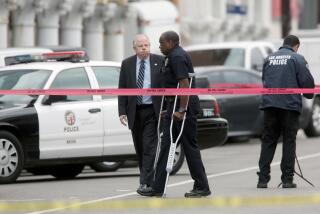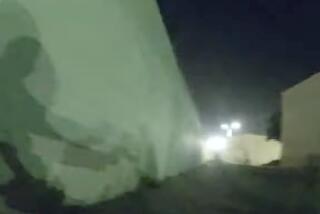N. Hollywood Suspect Tried to Hasten Death, Officer Testifies
- Share via
A Los Angeles police detective testified Tuesday that he believed that a robbery suspect who was shot 29 times in a running gun battle with police was “trying to commit suicide” after his capture by thrashing around in the street to speed up his bleeding.
“He was trying to bleed out. He was moving around and kicking,” Det. James Vojtecky told a jury in U.S. District Court. The detective said that when he tried to talk with Emil Matasareanu, the injured man responded with obscenities, telling the detective, “Shoot me in the head.”
Vojtecky, Los Angeles Police Department Officer John Futrell and the city of Los Angeles are defendants in a civil suit alleging they withheld medical care and deliberately let the handcuffed Matasareanu bleed to death in the street after a shootout in North Hollywood the morning of Feb. 28, 1997.
Matasareanu and a second gunman died, and 17 police officers and bystanders were injured, as the robbers, firing automatic weapons, sprayed about 1,100 armor-piercing rounds during the shootout, carried on live television.
Vojtecky, who retired in 1997 after 27 years on the force, said letting Matasareanu die “was the last thing I wanted to do.”
Contradicting the earlier testimony of co-defendant Futrell, Vojtecky said it was obvious Matasareanu was bleeding “severely.” The flesh on his left arm was shredded by gunshots, Vojtecky said, and his pants were soaked with blood. Futrell had testified that he noticed gunshot wounds only to Matasareanu’s ankles.
Vojtecky said he told Futrell he was afraid Matasareanu was trying to hasten his own death, and ordered the West Valley patrol officer to prevent the suspect from moving.
“You’re not dying on my watch, pal,” the detective testified he said as he knelt in the street to talk to the gunman. Matasareanu was lying face down, his hands cuffed behind his back.
Under questioning by the Matasareanu family’s attorney, Stephen Yagman, Vojtecky read a section from the LAPD’s policy manual stating that officers have a duty to seek treatment for wounded suspects.
Vojtecky denied Tuesday that he waved an ambulance crew away from Matasareanu that morning, saying he wanted the suspect to survive so he could someday face him in court. “I never directed anybody to stay away from that suspect, especially medical assistance,” Vojtecky testified. He added that he was “surprised” when a first ambulance drove away without the suspect, claiming that he exchanged “choice” words with the crew and demanded that a second ambulance be sent for the suspect.
The crew did not acknowledge him, Vojtecky testified, and a second ambulance did not arrive until about 45 minutes later.
The driver of the first ambulance, Alan R. Skier, said the dispatcher canceled the order for the rescue as he turned the corner. But on the street ahead, he testified, a uniformed police officer frantically waved him forward. He drove onto the scene, which had not yet been declared safe by police. He testified that his actions violated city policy.
Skier told the jury a plainclothes police officer standing over the fallen gunman ordered him to “get the . . . out of here,” that they were in a “kill zone” and there were other armed suspects in the area.
In court, Skier could not identify Vojtecky as the officer who ordered him away from the injured gunman. By then, he said, he had treated a man with a head wound, a police officer with a grazing wound and a frightened man.
Skier, a city firefighter trained as an emergency medical technician, testified that Matasareanu looked dead to him when he arrived on the scene at 10:08 a.m.--within 10 minutes of the gunman’s surrender. He said he was surprised when he saw him take a breath.
“He looked like a dead body,” Skier recalled. “He was at death’s door. No way could I drag him 50 feet to my ambulance without making his injuries worse.”
Skier said he believed the officer who ordered him to leave was trying to keep him from being shot.
Most of the day was spent questioning Vojtecky, who exchanged shots with Matasareanu, handcuffed him and took charge of the crime scene moments after he surrendered.
The air in the courtroom of U.S. District Judge Christina Snyder crackled with tension and hostility as the detective, who investigated homicides for 14 years, fended off questions by Yagman and Victor Sherman, attorneys for Matasareanu’s two sons.
“In your mind, you wanted the suspect to live?” Sherman asked.
“Today, yesterday, last year and two and three years ago,” Vojtecky shot back.
“You didn’t want him to die, is that your testimony?” Sherman persisted.
“I wanted to see him in court,” the detective answered.
Attorneys also played more than a dozen video outtakes, showing Vojtecky slapping handcuffs on Matasareanu and smoking cigarettes as he stood over the fallen man.
Vojtecky said he smoked after the shootout because he was scared.
On one tape, Matasareanu is heard pleading with Vojtecky, “Roll me up, roll me up, roll me up” to a sitting position. The detective complied but laid him back down after he began bleeding more profusely.
Another video showed a man, identified by Vojtecky as North Hollywood Det. George Armenta, kicking the suspect and prodding him with his foot. A few minutes later, the video showed Armenta and Sgt. Israel “Sonny” Medina slapping their open palms in a congratulatory “low five” over the mortally wounded suspect.
On the witness stand, Vojtecky distanced himself from their actions. “I wasn’t anywhere near the suspect” at that point, he said, “or I would have tried to stop that garbage.”
More to Read
Sign up for Essential California
The most important California stories and recommendations in your inbox every morning.
You may occasionally receive promotional content from the Los Angeles Times.










